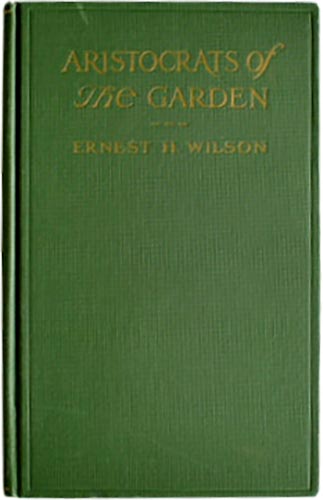
Musings » Aristocrats of the Garden


Boston, Massachusetts The Stratford Company 1932
Ernest H. Wilson was one of the very greatest of the late imperial plant explorers and author of numerous excellent books. Wilson opened his last book by deploring the fact that many wonderful plants were neglected by the gardening public. He had spent more than thirty years in finding new plants in China and the Far East, sending them back first to the firm of Veitch in England, his original employers, and later to the Arnold Arboretum after Veitch ceased business.
Veitch was a family firm which went back to the beginning of the nineteenth century, son succeeding father for many generations until Sir Harry Veitch closed it in 1917. In mid-century they sent William Lobb to the Americas, thus assuring themselves of major horticultural coups with such plants as the handsome beech, Nothofagus obliqua , Lapageria rosea (named for the Empress Josephine), Araucaria seeds and Tropaeolum azureum from Chile and Wellingtonia from the American west.
Veitch also employed William Lobb’s younger brother Thomas. It was he who travelled to Malaya and India and many other tropical places and brought back incomparable orchids. William Lobb liked California so well he never returned to England. In later life he developed a mysterious paralysis and died in San Francisco. He was buried in Mountain View cemetery.
At the end of the nineteenth century Veitch was seeking a single tree. This was a unique plant which had been described initially by Père Armand David in 1862, the “dove tree” or “pocket handkerchief tree” (Davidia involucrata). Slightly inconspicuous flowers were shielded by two elongated white bracts at the height of the flowering season. As the wind stirred the branches of the tree these bracts fluttered in the breeze, looking like white birds’ wings.
Wilson said toward the end of his life that this tree was the pinnacle of everything he had sought in Oriental plants. He left on his first trip to China in March 1899. Finding the tree was a miracle. Wilson was actually looking for one single specimen, not a group or grove of trees. This tree had been recorded by another amazing plant hunter, Dr Augustine Henry, in the early 1880s. It was the only one known to Western explorers. Wilson actually reached the village where Henry had seen the tree but its owner had cut it down to build a house. Instead of sitting around feeling sorry for himself, Wilson explored the region in depth and found another specimen. Wilson recorded his journey with all its painful disappointments but ulitmate success in great detail.
Ernest H. Wilson was born in the small country town of Chipping Hamden in Gloucestershire, and may be one of its most illustrious citizens. The way he came to be an extremely successful plant explorer is one of those heartening “poor boy makes good” stories. Some years ago the town opened a special memorial garden containing many of the plants he took back to England. Wilson was not content simply to be a jobbing gardener but took night courses in English and botany and found his way to the trainee program at the Royal Botanic Gardens at Kew. There he did his work so thoroughly that when Veitch came looking for a likely lad to travel for him, the director, Sir John Thistleton-Dwyer, recommended Wilson.
Wilson felt it was really sad that after all the amazing plants he and his colleagues had introduced into English and American horticulture that so many of them were neglected or essentially unknown. He termed them “Aristocrats” because of their beauty and structural qualities. Nowadays a very different plaint can be sung. Native plants are no longer given the time of day. Everyone rushes after the new nine day wonders.
The largest part of Wilson’s book of the book discusses the major groups of garden plants favored by most people: roses, lilac, rhododendrons, ornamental fruit trees etc. He described 518 species of mainly Oriental plants which had been imported into the British Isles or the United States and which were known to be hardy in at least one or more regions of these countries. In addition he commented on numerous plants native to various sections of the United States, some of which had ended up in England in earlier periods.
Hardiness was the chief requirement for selecting a destination in the Far East. It was no good finding an exquisite plant if it died the first year anyone planted it. We now have ornamental vines and rhododendrons for example which can withstand the rigors of a Massachusetts or Wisconsin winter because Wilson and his confrères spent months in miserable conditions crawling about misty windswept rocks thousands of feet above sea level.
This book was written 82 years ago, and first published in 1926. Wilson and his wife were tragically killed in a car accident in 1930, driving back to Jamaica Plain from his daughter’s house in upstate New York. He is buried in Montreal, on “British” soil.

